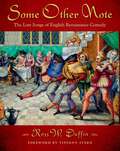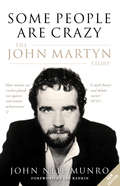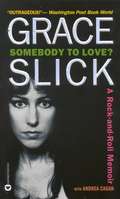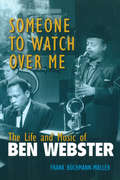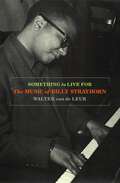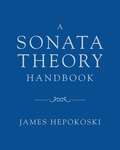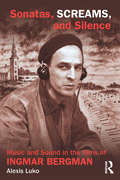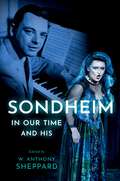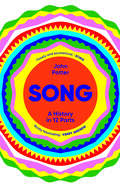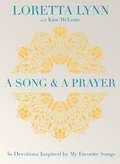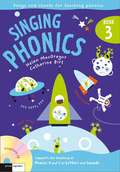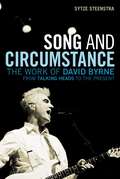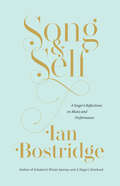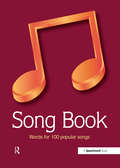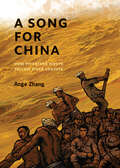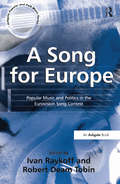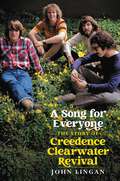- Table View
- List View
Some Other Note: The Lost Songs of English Renaissance Comedy
by Ross W. DuffinEnglish comedy from the fifteenth to the early seventeenth century abounds in song lyrics, but most of the original tunes were thought to have been lost--until now. By deducing that playwrights borrowed melodies from songs they already knew, Ross W. Duffin has used the existing English repertory of songs, both popular and composed, to reconstruct hundreds of songs from more than a hundred plays and other stage entertainments. Thanks to Duffin's incredible breakthrough, these plays have been rendered performable with period music for the first time in five hundred years. Some Other Note not only brings these songs back from the dead, but tells a thrilling tale of the investigations that unraveled these centuries-old mysteries.
Some Other Note: The Lost Songs of English Renaissance Comedy
by Ross W. DuffinEnglish comedy from the fifteenth to the early seventeenth century abounds in song lyrics, but most of the original tunes were thought to have been lost--until now. By deducing that playwrights borrowed melodies from songs they already knew, Ross W. Duffin has used the existing English repertory of songs, both popular and composed, to reconstruct hundreds of songs from more than a hundred plays and other stage entertainments. Thanks to Duffin's incredible breakthrough, these plays have been rendered performable with period music for the first time in five hundred years. Some Other Note not only brings these songs back from the dead, but tells a thrilling tale of the investigations that unraveled these centuries-old mysteries.
Some People Are Crazy: The John Martyn Story
by John Neil MunroDescribed recently by Empire magazine as 'Britain's best ever blues singer', John Martyn was one of rock music's last real mavericks. Despite long-term addiction to alcohol and drugs, which contributed to his death in January 2009, he produced a string of matchless albums. Loved by fans and critics, loathed by ex-managers, he survived the music business he despised for 40 years. With contributions by Martyn, many of his lovers and over 20 musicians who knew him well, this book documents his upbringing in Glasgow and rise through the Scottish and London folk scene of the 1960s, his many highs and lows, and his friendships with the great lost souls of British rock music - Nick Drake and Paul Kossoff.
Somebody to Love?: A Rock-and-Roll Memoir
by Grace Slick Andrea CaganA candid autobiography of the great rock diva of Jefferson Airplane and Jefferson Starship, revealing her wild life at the forefront of the Sixties and Seventies counterculture.She has been called rock and roll's original female outlaw, as famous for her bad behavior as for her haunting singing voice. In her 25-year career as a musician, Grace Slick charted dozens of hits and sold millions of albums. From "White Rabbit" and "Somebody to Love" to "Sarah" and "Miracles", the songs she performed became the anthems of a generation.Whether describing her antics at the White House with Abbie Hoffman or the unforgettable experience that was Woodstock, Slick's recollections have the same rich imagery found in her lyrics. In this provocative narrative, readers will discover the many sides of Grace Slick: as artistic pioneer; she records songs with Jerry Garcia and David Crosby; as practitioner of freedom and rebellion; she sleeps with Jim Morrison and gets arrested for DUI on three separate occasions (without actually being in a car); and as a loving mother to actress China Kantner, she tries to balance casual friendship with parental wisdom.Slick offers a revealing self-portrait of the complex woman behind the rock-outlaw image, and delivers a behind-the-scenes, no-holds-barred view of the people and spirit that defined a quarter-century of American pop culture. Wildly funny, candid, and evocative, Somebody to Love?tells what it was really like during, and after, the Summer of Love-and how one remarkable woman survived it all to remain today as vibrant and rebellious as ever.
Someone to Watch Over Me: The Life and Music of Ben Webster (Jazz Perspectives)
by Frank Büchmann-MøllerFor a half century, Ben Webster, one of the "big three" of swing tenors-along with Coleman Hawkins and Lester Young-was one of the best-known and most popular saxophonists. Early in his career, Webster worked with many of the greatest orchestras of the time, including those led by Willie Bryant, Cab Calloway, Benny Carter, Fletcher Henderson, Andy Kirk, Bennie Moten, and Teddy Wilson. In 1940 Webster became Duke Ellington's first major tenor soloist, and during the next three years he played on many famous recordings, including "Cotton Tail." Someone to Watch Over Me tells, for the first time, the complete story of Ben Webster's brilliant and troubled career. For this comprehensive study of Webster, author Frank Büchmann-Møller interviewed more than fifty people in the United States and Europe, and he includes numerous translated excerpts from European periodicals and newspapers, none previously available in English. In addition, the author studies every known Webster recording and film, including many private recordings from Webster's home collection not available to the public. Exhaustively researched, this is a much needed and long overdue study of the life and music of one of jazz's most important artists.
Something to Live For: The Music of Billy Strayhorn
by Walter van de LeurDuke Ellington was one of jazz's greatest figures, a composer and bandleader of unparalleled importance and influence. But little attention has been given to his chief musical collaborator, Billy Strayhorn, who created hundreds of compositions and arrangements for his musical partner, and without whom the sound of Ellington's orchestra would have been very different. Now, in Walter van de Leur's provocative new book, Something To Live For, Billy Strayhorn steps out from Ellington's shadow and into the spotlight. Van de Leur argues that far from being merely a follower of Ellington or his alter ego, Strayhorn brought a radically new and visionary way of writing to the Ellington orchestra. Making extensive use, for the first time, of over 3,000 autograph scores, Van de Leur separates Strayhorn from Ellington, establishes who wrote what, and clearly distinguishes between their distinctive musical styles. "Both Strayhorn's and Ellington's oeuvres," writes Van de Leur, "though historically intertwined, nevertheless form coherent, separate musical entities, especially in terms of harmonic, melodic, and structural design." Indeed, Something to Live For allows us to see the characteristic features of Strayhorn's compositions and arrangements, his "musical fingerprints," and to analyze and evaluate his music on its own terms. The book also makes clear that Strayhorn's contribution to the band was much larger, and more original, than has been previously acknowledged. Based on a decade of research and offering detailed analyses of over 70 musical examples, Something to Live For casts new light--and will surely arouse intense debate--on two of the most important composers in the history of jazz.
A Sonata Theory Handbook
by James HepokoskiSonata form is the most commonly encountered organizational plan in the works of the classical-music masters, from Haydn, Mozart, and Beethoven to Schubert, Brahms, and beyond. Sonata Theory, an analytic approach developed by James Hepokoski and Warren Darcy in their award-winning Elements of Sonata Theory (2006), has emerged as one of the most influential frameworks for understanding this musical structure. What can this method from "the new Formenlehre" teach us about how these composers put together their most iconic pieces and to what expressive ends? In this new Sonata Theory Handbook, Hepokoski introduces readers step-by-step to the main ideas of this approach. At the heart of the book are close readings of eight individual movements from Mozart's Piano Sonata in B-flat, K. 333, to such structurally complex pieces as Schubert's "Death and the Maiden" String Quartet and the finale of Brahms's Symphony No 1 that show this analytical method in action. These illustrative analyses are supplemented with four updated discussions of the foundational concepts behind the theory, including dialogic form, expositional action zones, trajectories toward generically normative cadences, rotation theory, and the five sonata types. With its detailed examples and deep engagements with recent developments in form theory, schema theory, and cognitive research, this handbook updates and advances Sonata Theory and confirms its status as a key lens for analyzing sonata form.
Sonatas, Screams, and Silence: Music and Sound in the Films of Ingmar Bergman
by Alexis LukoSonatas, Screams, and Silence: Music and Sound in the Films of Ingmar Bergman is the first musical examination of Bergman’s style as an auteur filmmaker. It provides a comprehensive examination of all three aspects (music, sound effects, and voice) of Bergman’s signature soundtrack-style. Through examinations of Bergman’s biographical links to music, the role of music, sound effects, silence, and voice, and Bergman’s working methods with sound technicians, mixers, and editors, this book argues that Bergman’s soundtracks are as superbly developed as his psychological narratives and breathtaking cinematography. Interdisciplinary in nature, this book bridges the fields of music, sound, and film.
Sonatas, Screams, and Silence: Music and Sound in the Films of Ingmar Bergman
by Alexis LukoSonatas, Screams, and Silence: Music and Sound in the Films of Ingmar Bergman is the first musical examination of Bergman’s style as an auteur filmmaker. It provides a comprehensive examination of all three aspects (music, sound effects, and voice) of Bergman’s signature soundtrack-style. Through examinations of Bergman’s biographical links to music, the role of music, sound effects, silence, and voice, and Bergman’s working methods with sound technicians, mixers, and editors, this book argues that Bergman’s soundtracks are as superbly developed as his psychological narratives and breathtaking cinematography. Interdisciplinary in nature, this book bridges the fields of music, sound, and film.
SONATA THEORY HANDBOOK C
by James HepokoskiSonata form is the most commonly encountered organizational plan in the works of the classical-music masters, from Haydn, Mozart, and Beethoven to Schubert, Brahms, and beyond. Sonata Theory, an analytic approach developed by James Hepokoski and Warren Darcy in their award-winning Elements of Sonata Theory (2006), has emerged as one of the most influential frameworks for understanding this musical structure. What can this method from "the new Formenlehre" teach us about how these composers put together their most iconic pieces and to what expressive ends? In this new Sonata Theory Handbook, Hepokoski introduces readers step-by-step to the main ideas of this approach. At the heart of the book are close readings of eight individual movements from Mozart's Piano Sonata in B-flat, K. 333, to such structurally complex pieces as Schubert's "Death and the Maiden" String Quartet and the finale of Brahms's Symphony No 1 that show this analytical method in action. These illustrative analyses are supplemented with four updated discussions of the foundational concepts behind the theory, including dialogic form, expositional action zones, trajectories toward generically normative cadences, rotation theory, and the five sonata types. With its detailed examples and deep engagements with recent developments in form theory, schema theory, and cognitive research, this handbook updates and advances Sonata Theory and confirms its status as a key lens for analyzing sonata form.
Sondheim in Our Time and His
by W. Anthony SheppardSondheim in Our Time and His offers a wide-ranging historical investigation of the landmark works and extraordinary career of Stephen Sondheim, a career which has spanned much of the history of American musical theater. Each author uncovers those aspects of biography, collaborative process, and contemporary context that impacted the creation and reception of Sondheim's musicals. In addition, several authors explore in detail how Sondheim's shows have been dramatically revised and adapted over time. Multiple chapters invite the reader to rethink Sondheim's works from a distinctly contemporary critical perspective and to consider how these musicals are being reenvisioned today. Through chapters focused on individual musicals, and others that explore a specific topic as manifested throughout his entire career, plus an afterword by Kristen Anderson-Lopez; by digging deep into the archives and focusing intently on his scores; from interviews with performers, directors, and bookwriters, and close study of live and recorded productions--volume editor W. Anthony Sheppard brings together Sondheim's past with the present, thriving existence of his musicals.
Sondheim in Our Time and His
Sondheim in Our Time and His offers a wide-ranging historical investigation of the landmark works and extraordinary career of Stephen Sondheim, a career which has spanned much of the history of American musical theater. Each author uncovers those aspects of biography, collaborative process, and contemporary context that impacted the creation and reception of Sondheim's musicals. In addition, several authors explore in detail how Sondheim's shows have been dramatically revised and adapted over time. Multiple chapters invite the reader to rethink Sondheim's works from a distinctly contemporary critical perspective and to consider how these musicals are being reenvisioned today. Through chapters focused on individual musicals, and others that explore a specific topic as manifested throughout his entire career, plus an afterword by Kristen Anderson-Lopez; by digging deep into the archives and focusing intently on his scores; from interviews with performers, directors, and bookwriters, and close study of live and recorded productions--volume editor W. Anthony Sheppard brings together Sondheim's past with the present, thriving existence of his musicals.
Song: A History in 12 Parts
by John PotterFrom one of our most innovative singers, a vibrant history of song stretching from Hildegard von Bingen and Benjamin Britten to Björk “Songs can be intensely personal (whether you hear them or sing them) and none of us would choose the same twelve songs as anyone else. My choices are based on decades of performing experience in many different genres, but I hope they will reveal aspects of our common humanity as the story evolves from the Middle Ages to the present.” In this celebratory account, author and singer John Potter tells the European story of song. The form has captivated audiences and excited performers for centuries, from the music of the troubadours and the Christian liturgy through classical composers such as Bach and Schumann up to Britten, Berio, and the rise of popular music. Choosing twelve key works, Potter offers a personal tour through this vital tradition, from John Dowland’s “Flow My Tears” to George Gershwin’s “Summertime.” Throughout, he reveals who wrote and sang these joyful masterpieces—and what they mean to singers and audiences today.
A Song and A Prayer: 30 Devotions Inspired by My Favorite Songs
by Loretta Lynn Kim McLeanExperience spiritual encouragement from the Queen of Country Music with this collection of devotionals and uplifting lyrics. It&’s been over sixty years since the late Loretta Lynn first rose to stardom, transforming from a coal miner&’s daughter to the Queen of Country Music. Loretta knew she was blessed—to record music, to sing her songs to such great crowds, and to write books. A Song and A Prayer is a collection of devotionals combined with song lyrics that delivers a unique form of worship. Inspired by her songwriting sessions with Kim McLean (a fellow songwriter, music producer, as well as ordained minister and reverend doctor), Loretta's love of God is felt on every page of this book. Readers will learn to experience and maintain an intimate one-on-relationship with God. This volume will become a cherished companion for Loretta Lynn fans and readers everywhere as they strive to live each precious moment to the fullest and happiest. Through A Song and A Prayer, readers of all faiths and walks of life will have the opportunity to bask in a month&’s worth of spiritual encouragement. Loretta&’s thoughts and lyrics not only capture the presence of God, but also capture a presence that transcends Christianity—the spirit of creativity. In a busy world, Loretta&’s lyrics and prayers remind readers that God loves them more than they could imagine.
Song And Chants For Teaching Phonics 3 (Singing Phonics Ser. (PDF))
by Catherine Birt Helen Macgregor Emily SkinnerA songbook to support the teaching of phonics through songs, chants and games, ideal for use alongside Letters and Sounds phases 4, 5 and 6. Continues the work of the successful Singing Phonics and Singing Phonics 2. Singing Phonics 3 is the third in the successful Singing Phonics song collection designed to support phonics teaching and enrich young children's experience of language in a fun and interactive way. It follows Singing Phonics and Singing Phonics 2, and is ideal for use with phases 4, 5 and 6 of the 'Letters and Sounds' phonics programme, published by the Primary National Strategy. It is a highly useful addition to any phonics scheme. Each song or chant is accompanied by a set of activities (including photocopiable resources) and ideas for further development. The pack includes a CD with sample performances. Many songs have familiar tunes, making Singing Phonics 3 a highly user-friendly resource with no music reading required.
Song and Circumstance: The Work of David Byrne from Talking Heads to the Present
by Sytze SteenstraFor over three decades now, David Byrne has been a leading light in American culture - in popular music, experimental theatre, film, television, fine art, and writing. Based on the cultural capital he gained with his groundbreaking band Talking Heads, Byrne is able to enter into collaborations with many artists, some of popular fame -Brian Eno and Jonathan Demme, for example - and others known best in more specialized circles - such as Joseph Kosuth, Twyla Tharp, and Caetano Veloso. The map of Byrne's collaborations, including the casual and incidental ones, reveals an ongoing effort to combine avant-gardism with popular appeal. This highly original and illustrated account of David Byrne's career is structured by choosing a specific abstract approach, or a combination of two approaches, for each chapter, discussing the parallels and contradictions between such approaches to benefit the interpretation of Byrne's art. As a result, the fertile conceptual brew that characterizes Byrne's way of making art is present from the beginning, while each chapter adds to thorough insight and developing perspective.
Song and Circumstance: The Work of David Byrne from Talking Heads to the Present
by Sytze SteenstraFor over three decades now, David Byrne has been a leading light in American culture - in popular music, experimental theatre, film, television, fine art, and writing. Based on the cultural capital he gained with his groundbreaking band Talking Heads, Byrne is able to enter into collaborations with many artists, some of popular fame -Brian Eno and Jonathan Demme, for example - and others known best in more specialized circles - such as Joseph Kosuth, Twyla Tharp, and Caetano Veloso. The map of Byrne's collaborations, including the casual and incidental ones, reveals an ongoing effort to combine avant-gardism with popular appeal. This highly original and illustrated account of David Byrne's career is structured by choosing a specific abstract approach, or a combination of two approaches, for each chapter, discussing the parallels and contradictions between such approaches to benefit the interpretation of Byrne's art. As a result, the fertile conceptual brew that characterizes Byrne's way of making art is present from the beginning, while each chapter adds to thorough insight and developing perspective.
Song and Self: A Singer's Reflections on Music and Performance (Berlin Family Lectures)
by Ian BostridgeAward-winning singer Ian Bostridge examines iconic works of Western classical music to reflect on the relationship between performer and audience. Like so many performers, renowned tenor Ian Bostridge spent much of 2020 and 2021 unable to take part in live music. The enforced silence of the pandemic led him to question an identity that was previously defined by communicating directly with audiences in opera houses and concert halls. It also allowed him to delve deeper into many of the classical works he has encountered over the course of his career, such as Claudio Monteverdi’s seventeenth-century masterpiece Il Combattimento di Tancredi e Clorinda and Robert Schumann’s popular song cycle Frauenliebe und Leben. In lucid and compelling prose, Bostridge explores the ways Monteverdi, Schumann, and Britten employed and disrupted gender roles in their music; questions colonial power and hierarchy in Ravel’s Songs of Madagascar; and surveys Britten’s reckoning with death in works from the War Requiem to his final opera, Death in Venice. As a performer reconciling his own identity and that of the musical text he delivers on stage, Bostridge unravels the complex history of each piece of music, showing how today’s performers can embody that complexity for their audiences. As readers become privy to Bostridge’s unique lines of inquiry, they are also primed for the searching intensity of his interpretations, in which the uncanny melding of song and self brings about moments of epiphany for both the singer and his audience.
Song and Self: A Singer's Reflections on Music and Performance (Berlin Family Lectures)
by Ian BostridgeAward-winning singer Ian Bostridge examines iconic works of Western classical music to reflect on the relationship between performer and audience. Like so many performers, renowned tenor Ian Bostridge spent much of 2020 and 2021 unable to take part in live music. The enforced silence of the pandemic led him to question an identity that was previously defined by communicating directly with audiences in opera houses and concert halls. It also allowed him to delve deeper into many of the classical works he has encountered over the course of his career, such as Claudio Monteverdi’s seventeenth-century masterpiece Il Combattimento di Tancredi e Clorinda and Robert Schumann’s popular song cycle Frauenliebe und Leben. In lucid and compelling prose, Bostridge explores the ways Monteverdi, Schumann, and Britten employed and disrupted gender roles in their music; questions colonial power and hierarchy in Ravel’s Songs of Madagascar; and surveys Britten’s reckoning with death in works from the War Requiem to his final opera, Death in Venice. As a performer reconciling his own identity and that of the musical text he delivers on stage, Bostridge unravels the complex history of each piece of music, showing how today’s performers can embody that complexity for their audiences. As readers become privy to Bostridge’s unique lines of inquiry, they are also primed for the searching intensity of his interpretations, in which the uncanny melding of song and self brings about moments of epiphany for both the singer and his audience.
Song Book: Words for 100 Popular Songs
by Ffion Mercer Speechmark SpeechmarkFeaturing large clear print, the "Song Book" contains the words to 100 popular songs that are ideal for group sing-along sessions. The book is divided into six sections: traditional folk songs, choruses from old time variety, songs from World War II, post-war evergreens, hymns, and Christmas songs.
Song Book: Words for 100 Popular Songs
by Ffion Mercer Speechmark SpeechmarkFeaturing large clear print, the "Song Book" contains the words to 100 popular songs that are ideal for group sing-along sessions. The book is divided into six sections: traditional folk songs, choruses from old time variety, songs from World War II, post-war evergreens, hymns, and Christmas songs.
A Song for China: How My Father Wrote Yellow River Cantata
by Ange ZhangPublished in celebration of the famous Yellow River Cantata’s 80th anniversary, this is the riveting history of how a young Chinese author and passionate militant fought using art to create a socially just China during the period of the struggle against the Japanese and during World War II.This is the fascinating story of how a young Chinese author, Guang Weiran, a passionate militant from the age of twelve, fought, using art, theater, poetry and song, especially the famous Yellow River Cantata — the anthem of Chinese national spirit — to create a socially just China. Set during the period of the struggle against the Japanese and the war against the Kuomintang in the 1920s and ’30s, this book, written and illustrated by Guang Weiran’s award-winning artist son, Ange Zhang, illuminates a key period in China’s history. The passion and commitment of the artists who were born under the repressive weight of the Japanese occupation, the remnants of the decaying imperial order and the times of colonial humiliation are inspiring.Zhang’s words and wood-block style of art tell us the story of his father’s extraordinary youth and very early rise to prominence due to his great talent with words. We see and hear the intensity of what it meant to be alive at such a significant moment in the history of China, a country that understands itself as the heir to one of the greatest civilizations the world has ever known. The humiliations and social injustice the Chinese people had endured in the colonial period were no longer bearable. And yet there were major factional differences between those who wanted to create a modern China. Ange’s words and art paint the picture for us through his father’s story, accompanied by sidebars that explain the historical context.The book ends in a burst of glorious color and song, with the words of Yellow River Cantata in Mandarin, as well as newly translated into English. This great song turns eighty years old in 2019, and will be sung and performed by huge orchestras and choirs around the world, as the Chinese diaspora has embraced the cantata as its own.Key Text Features historical context sidebars illustrations lyricsCorrelates to the Common Core State Standards in English Language Arts:CCSS.ELA-LITERACY.RI.6.2 Determine a central idea of a text and how it is conveyed through particular details; provide a summary of the text distinct from personal opinions or judgments.CCSS.ELA-LITERACY.RI.6.6 Determine an author's point of view or purpose in a text and explain how it is conveyed in the text.CCSS.ELA-LITERACY.RI.6.7 Integrate information presented in different media or formats (e.g., visually, quantitatively) as well as in words to develop a coherent understanding of a topic or issue.
A Song for Europe: Popular Music and Politics in the Eurovision Song Contest
by IVAN RAYKOFF and ROBERT DEAM TOBINThe world's largest and longest-running song competition, the Eurovision Song Contest is a significant and extremely popular media event throughout the continent and abroad. The Contest is broadcast live in over 30 countries with over 100 million viewers annually. Established in 1956 as a televised spectacle to unify postwar Western Europe through music, the Contest features singers who represent a participating nation with a new popular song. Viewers vote by phone for their favourite performance, though they cannot vote for their own country's entry. This process alone reveals much about national identities and identifications, as voting patterns expose deep-seated alliances and animosities among participating countries. Here, an international group of scholars from a variety of disciplines, including musicology, communications, history, sociology, English and German studies, explore how the contest sheds light on issues of European politics, national and European identity, race, gender and sexuality, and the aesthetics of camp. For some countries, participation in Eurovision has been simultaneously an assertion of modernity and a claim to membership in Europe and the West. Eurovision is sometimes regarded as a low-brow camp spectacle of little aesthetic or intellectual value. The essays in this collection often contradict this assumption, demonstrating that the contest has actually been a significant force and forecaster for social, cultural and political transformations in postwar Europe.
A Song for Europe: Popular Music and Politics in the Eurovision Song Contest
by RobertDeam TobinThe world's largest and longest-running song competition, the Eurovision Song Contest is a significant and extremely popular media event throughout the continent and abroad. The Contest is broadcast live in over 30 countries with over 100 million viewers annually. Established in 1956 as a televised spectacle to unify postwar Western Europe through music, the Contest features singers who represent a participating nation with a new popular song. Viewers vote by phone for their favourite performance, though they cannot vote for their own country's entry. This process alone reveals much about national identities and identifications, as voting patterns expose deep-seated alliances and animosities among participating countries. Here, an international group of scholars from a variety of disciplines, including musicology, communications, history, sociology, English and German studies, explore how the contest sheds light on issues of European politics, national and European identity, race, gender and sexuality, and the aesthetics of camp. For some countries, participation in Eurovision has been simultaneously an assertion of modernity and a claim to membership in Europe and the West. Eurovision is sometimes regarded as a low-brow camp spectacle of little aesthetic or intellectual value. The essays in this collection often contradict this assumption, demonstrating that the contest has actually been a significant force and forecaster for social, cultural and political transformations in postwar Europe.
A Song For Everyone: The Story of Creedence Clearwater Revival
by John LinganThe definitive biography of Creedence Clearwater Revival, exploring the band's legendary rise to fame and how their music embodied the cultural landscape of the late '60s and early '70sFrom 1969 to 1971, as the United States convulsed with political upheaval and transformative social movements, no band was bigger than Creedence Clearwater Revival. They managed a two-year barrage of top-10 singles and LPs that doubled as an ubiquitous soundtrack to one of the most volatile periods in modern American history, and they remain a staple of classic rock radio and films about the era. Yet despite their enduring popularity, no book has ever sought to understand Creedence in conversation with their time. A Song for Everyone finally tells that story: the thirteen-year saga of an unassuming suburban quartet's journey through the wilds of 1960s pop, and their slow accrual of a sound and ethos that were almost mystically aligned with the concerns of decade's end. Starting in middle school, these Californian friends and brothers cut a working-class path through the most expansive decade in American music, playing R&B, country, and rock 'n' roll under a variety of names as each of those genres expanded and evolved. When they finally synthesized those styles under a new name in 1968, Creedence Clearwater Revival became instantly epochal, then fell apart under the weight of personal grievances that dated back to adolescence. As musicians and as men, they embodied the contradictions and difficulties of their time, and those dimensions of their career have never been explored until now.Drawing on wide-ranging research into the social and musical developments of 1959-1972, extensive original interviews with surviving Creedence members and associates, and unpublished memoirs from people who knew the group closely, A Song for Everyone is the definitive account of a legendary and still-beloved American band. At the same time, it is also a cultural history of those same years—from Elvis to Altamont, Eisenhower to Watergate—seen through the eyes of four men who encapsulated them in song for all time, told by one of the rising figures in contemporary music writing.
